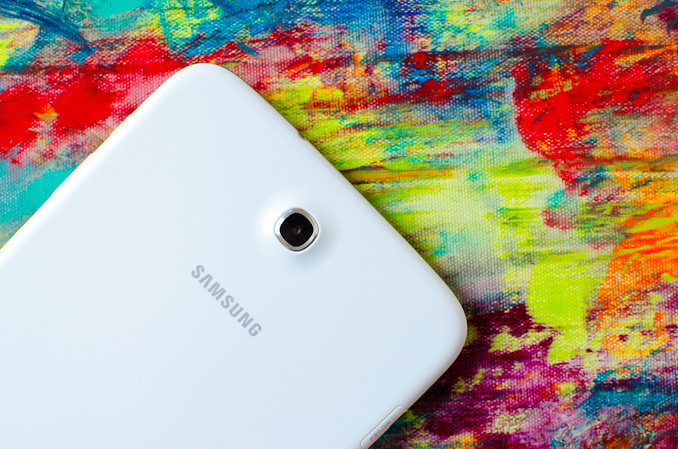Samsung Galaxy Note 8.0 Review
by Anand Lal Shimpi on April 17, 2013 11:29 PM EST- Posted in
- Tablets
- Samsung
- Android
- Mobile
- Galaxy Note 8.0
Camera
Although it’s sometimes used as one, I still don’t believe the majority of the population uses a tablet as their primary imaging device. That doesn’t however mean that it can’t be used as as a camera. In fact, I do see an increasing number of situations where tablets are being used as cameras in a pinch. Particularly on the productivity side of things where you may need to take a photo of something you’re studying on site (e.g. insurance adjuster taking photos of a claim). All of this is a long winded way of saying that tablet camera performance matters. It doesn’t perhaps matter as much as it would in a smartphone, but it still matters.
The Galaxy Note 8.0 comes with a fairly standard two camera setup. Around back there’s a raised bump to accommodate a 5MP camera module (2560x1920) with F2.7 lens. Up front there’s a 1.3MP sensor (1280x960) and F2.8 lens. Neither camera has a flash of any sort.
The Note 8.0’s size actually doesn’t make it ridiculous to take photos with. The camera UI is fairly standard for Samsung and includes a fairly typical set of customization options (ISO, exposure adjustment, JPEG compression, etc...). Shot to shot latency is about on par with the iPad mini, but considerably slower than the latest and greatest smartphones like the HTC One.
Camera preview is relatively smooth but clearly not anywhere near full resolution, as a result photos tend to look pretty bad during framing but can come out surprisingly decent once captured.
Samsung integrates optional voice recognition with its camera app. You can say smile, cheese, capture or shoot to activate the shutter. The process works surprisingly well but it does add additional latency to shooting since the voice recognition isn’t instant. Oddly enough some words worked better than others for me, although accuracy improved the closer my face was to the tablet.
Image quality outdoors was surprisingly decent. Both the Galaxy Note 8.0 and iPad mini did relatively well on camera duty. Samsung's auto white balance could definitely use some work, and in lower light scenarios the iPad mini seems to resolve details better than the Note 8.0.
 |
|||||||||
| Outdoor 1 | Indoor | Outdoor Nature | Macro | Outdoor Low Light | |||||
| Apple iPad mini | |||||||||
| Samsung Galaxy Note 8.0 | |||||||||
Low light performance is horrible on both tablets. In well lit scenarios, the Note 8.0 is a competent shooter though the iPad mini seems to do better overall. I was personally surprised by how well these tablets performed at macro shots. Again, I wouldn't use either as a primary shooter, but if your job requires embedding photos in emails and all you're carrying is one of these tablets you can make it work (assuming there's plenty of light around).
Video recording performance was also surprisingly decent on the Galaxy Note 8.0:


















95 Comments
View All Comments
Ashley1989 - Thursday, April 18, 2013 - link
Hi, I'm awaiting for the launch of this machine in India, expected somewhere in the end of April. I'm inclined towards its sleek design and its task switcher feature. Its available on S3 too if you update your software. Can't wait to install One browser to it, download and surf at lightening speed. Its gonna be a deadly combo.superflex - Thursday, April 18, 2013 - link
No Editors Choice award?Enjoy the wrath of the Samsung Fanbois.
herts_joatmon - Thursday, April 18, 2013 - link
This is the first review i've read to date on this that talks about the s-pen as a drawing tool and compares it to a similar product (the surface in this case). The main reason I wanted this was to use as a mobile sketchpad. I have concerns now having read that its not upto the standard of the surface pro. Saying that, I cant afford the Surface pro so I may have no other choice than this. Was it the pen itself that was the issue? Have your tried it with other Wacom pens? I've already gone out and bought the seperate s pen with erraser for the improved ergonomics and functionality assuming it would be a better experience than the standard pen supplied.Arbie - Thursday, April 18, 2013 - link
This is a real prospect for me. The screen size is just large enough to enjoy videos, while still being portable.What I really appreciate is the SD card slot. On a device so capable of media playback, it's a no-brainer to include a tiny, low-cost way of instantly swapping libraries of content in and out. The size of the internal storage is irrelevant to this - nothing beats micro/SD for loading and unloading media sets. The companies that omit SD in order to force higher prices for internal storage (!) will never get my business.
nerd1 - Thursday, April 18, 2013 - link
Still some company is charging $100 for extra 16GB while you can get 32GB card at $20.antef - Thursday, April 18, 2013 - link
lol, a menu button on a tablet??? Users will probably never even notice it's there. Imagine such a thing on an iPad or Nexus 10.Samsung just doesn't get it.
nerd1 - Thursday, April 18, 2013 - link
It actually helps a lot to have external buttons on tablet, as it won't eat up screen real estate.I hate permanent on-screen buttons.
Calista - Thursday, April 18, 2013 - link
Fully agree, have always found the onscreen buttons of HC and ICS a bit akward, to easy to hit by mistake. But I guess real buttons would hinder the idea that the tablet should be able to be turned any way the user please. Unfortunately it still won't work that way since we always have the power and volume button and the speakers in fixed positions.antef - Thursday, April 18, 2013 - link
The problem with real buttons is flexibility. If you include a hardware menu key (Samsung), it creates a bad, disjointed UI experience and a button that sometimes does nothing depending on the app you're in. An app's functionality should be fully contained with the app's UI and a button off-screen to pull up some functions is not smart design. It's also completely inconsistent ith 10" tablets and thus hard for new users to learn which is why Google axed it. However, if you don't include a hardware menu key (HTC), you're stuck with a full-row black menu bar for legacy apps that expect an off-screen menu key. On-screen keys eliminate this issue and let you have the best of both worlds.HanakoIkezawa - Thursday, April 18, 2013 - link
Im sorry but I fail to see how having dedicated buttons off screen create a broken experience in any way, shape or form. I for one cannot stand having wasted pixels on screen or having no dedicated